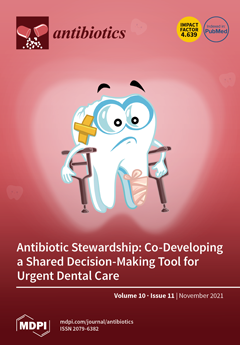This study aimed to determine the global prevalence and molecular characterization of CTX-M-producing
Salmonella Typhimurium isolates. A total of 330 (15.2%, 330/21779)
blaCTX-M-positive
S. Typhimurium were obtained from the public databases in July 2021. Thirteen variants were found in the 330 members of the
blaCTX-M group, and
blaCTX-M-9 (26.4%, 88/330) was the most prevalent. The majority of
blaCTX-M-positive
S. Typhimurium were obtained from humans (59.7%, 197/330) and animals (31.5%, 104/330). The number of
blaCTX-M-positive
S. Typhimurium increased annually (
p < 0.0001). These isolates were primarily found from China, the United Kingdom, Australia, the USA, and Germany. In addition, these isolates possessed 14 distinct sequence types (ST), and three predominated: ST34 (42.7%, 141/330), ST19 (37.0%, 122/330), and ST313 (10.3%, 34/330). The majority of ST34
S. Typhimurium isolates were distributed in China and mainly from swine. However, the majority of ST19 were distributed in the United Kingdom and Australia. Analysis of contigs showed that the major type of
blaCTX-M-carrying plasmid was identified as IncI plasmid (52.9%, 27/51) and IncHI2 plasmid (17.6%, 9/51) in 51
blaCTX-M-positive S. Typhimurium isolates. In addition, WGS analysis further revealed that
blaCTX-M co-existed with nine antibiotic-resistant genes with a detection rate over 50%, conferring resistance to five classes of antimicrobials. The 154 virulence genes were detected among these isolates, of which 107 virulence genes were highly common. This study revealed that China has been severely contaminated by
blaCTX-M-positive
S. Typhimurium isolates, these isolates possessed numerous ARGs and virulence genes, and highlighted that continued vigilance for
blaCTX-M-positive
S. Typhimurium in animals and humans is urgently needed.
Full article






